ANGKOR WAT – A GLORIOUS FALLEN CIVILIZATION
by Hans Tammemagi
(For Travel Writers' Tales )
In spite of torrid heat and sweat dripping down my back, I was captivated by the sight before me. Banyan roots the thickness of a horse's torso entwined the stones of a huge temple, crushing them, twisting them and ever so slowly taking command of this patch of Cambodian jungle. This was the Ta Prohm Temple in Angkor Wat and I could see why scenes from Lara Croft: Tomb Raider were filmed here. It was mystical, humbling and unearthly.
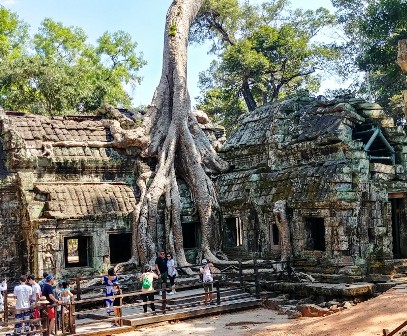
Banyan tree slowly overcomes stone temple
Fulfilling a childhood dream, I had joined a tour of southeast Asia, drawn, in particular, by Angkor Wat, the world's largest temple complex with 295 temples on a 400-acre site. I discovered there aren't enough superlatives to describe this UNESCO world heritage site. As we drove around, temples would appear by the roadside or peer at us from further inside the jungle. We crossed bridges lined with stone statues. Monkeys swung from trees and scampered among the ruins.
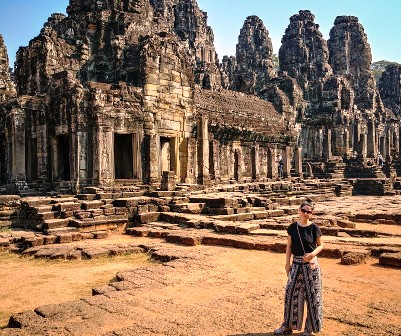
One of many temples at Angkor Wat
Built in the early 1100s, Angkor was dedicated to the Hindu god Vishnu and was the capital of the Khmer Empire from the ninth to the fifteenth centuries. One of the greatest human-made places on the Earth, it is staggering that such an enormous, graceful complex was built 900 years ago.
That evening a tour-mate and I wondered how such a mighty civilization could crumble in the 1500s. Today we had seen how trees, the strongest ones in nature, could crush temples made of stone. I wondered about our present civilization. Could it last? How would it be remembered nine centuries from now?
But to return to the outset of our journey: it had started in Hanoi in northern Vietnam. We then travelled south to the vibrant Ho Chi Minh City (Saigon). At the outstanding War Remnants Museum and the nearby immense tunnel network I witnessed the horror the USA unleashed on Vietnam. We then entered Cambodia, which suffered even greater brutality. In Phnom Penh, the capital, we visited one of the killing fields where the Khmer Rouge murdered two million of its own citizens or 25 % of its population. I held back tears, wondering how human beings could sink to such depravity. Today, the country is at peace and known as the land of a thousand smiles and a thousand sorrows.
We then boarded the bus and headed through the rural countryside to Angkor Wat. En route we disembarked at a happy-spot (toilet stop) and a cute girl promptly placed giant hairy tarantulas on us. She smiled as we shrieked in shock. After numerous photos, she accepted donations, placed all the spiders back in a jar and then sought out another bus.
During our trip, Sal, our guide insisted we sample fried silk worms, tarantulas, crickets and cockroaches. “Because Cambodia is poor, fried insects are a popular food,” he said. Surprisingly, they had a nice crunch and didn't taste too bad.
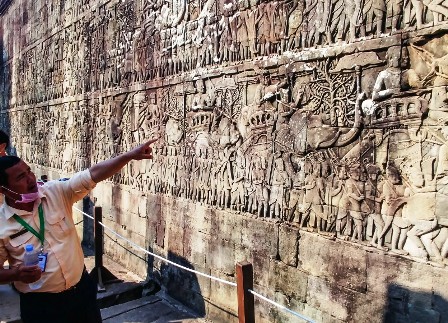
Intricate 900-year-old carvings
We stayed at a hotel on a pot-holed street in Siem Reap and next morning boarded tuk tuks to the Angkor Wat complex to tour one of the temples. Its walls were intricately carved with Buddhas, elephants, numerous warriors, and beautiful dancer-consorts called apsaras . Giant stone Buddha faces looked down from high towers. The wear and tear of centuries revealed many stones out of place, often broken and badly weathered.
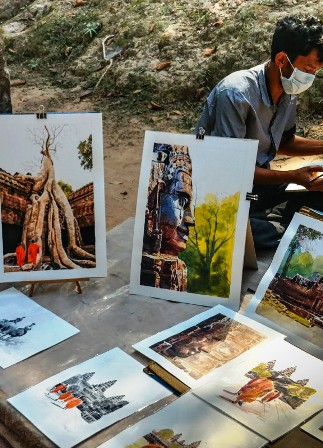
Artist sells his paintings
At temple entrances, artists painted and sold souvenir pictures. Small groups of legless men — landmine victims — played strange instruments, appealing (successfully) to our generosity. The jungle pressed in everywhere. Dominating the luxuriant foliage were towering banyan trees with their large roots curving over or through walls in a powerful, yet almost casual, manner.
The temples, consisting entirely of ancient grey stones, had no decorations, but occasionally we encountered a splash of colour at the sight of a monk sitting cross-legged in a saffron robe with candles flickering in the dusk.
Back in Siem Reap, we found Pub Street, which was alive with crowds, thumping music and boisterous parties. Restaurants and bars proliferated, most serving beer at the bargain price of 50 cents (US). We enjoyed dinner and a traditional Apsara performance with dancers wearing bright colours; their movements, including complicated hand positions, were slow and symbolic.
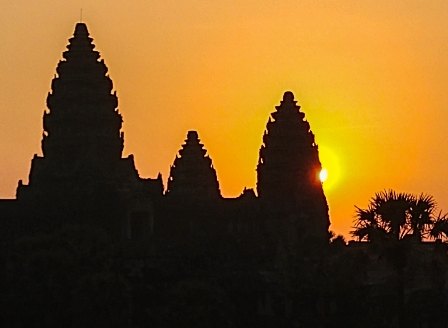
Sunrise over Angkor Wat
At 5 am the following morning we watched the sun rise. Sleepy-eyed, we joined a vast crowd all waving their cell phones toward the east. The sun rose, slowly casting a scarlet halo around the temple. It was magnificent and remains one of my most vivid memories of this exotic and spiritual place.
_____________________________________
Travel Writers' Tales is an independent travel article syndicate that offers professionally written travel articles to newspaper editors and publishers. To check out more, visit www.travelwriterstales.com
IF YOU GO:
- Tours with G Adventures to VietNam, Cambodia and Thailand includes Angkor Wat
https://www.gadventures.com/trips/essential-vietnam-and-cambodia/AVEV/
- Learn about Angkor Wat at: https://www.tourismcambodia.com/attractions/angkor/angkor-wat.htm
PHOTOS by Hans Tammemagi